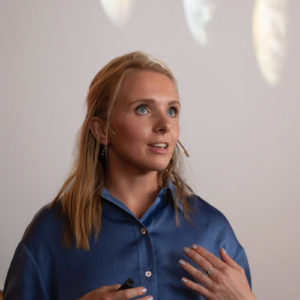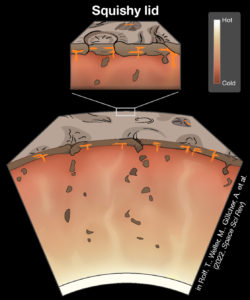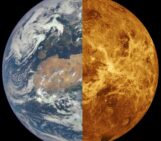
Our neighbouring planet Venus is gaining popularity in the terrestrial planetary sciences, especially since the selection of three new Venus missions by NASA and ESA in 2021. Now, for the first time ever, scientists have directly observed surface changes that indicate active volcanism on Venus. This discovery was made with data from NASA’s 30-year-old Magellan mission and is only a small preview for the incredible discoveries the future fleet of Venus missions will make. In today’s Peculiar Planets post, Anna Gülcher (postdoc at the NASA Jet Propulsion Laboratory and California Institute of Technology) sheds light on this stunning new finding, the role of geodynamical modelling in unravelling Venus’ secrets, and the upcoming missions to our sister planet.
The smoking gun: an active volcano on Venus
 Venus is the second planet from the Sun, and most like Earth in terms of size, mass, and chemical makeup. But whereas Earth’s environment is habitable, that of Venus is harsh with a crushingly thick atmosphere over an extremely hot, rocky desert surface. Interestingly, Venus has no plate tectonics as-we-know-it on Earth, where it is a crucial process responsible for surface features, chemical cycles, and perhaps even life. Yet, Venus’s surface is littered by many tectonic and volcanic features, and it remains a question how these structures reflect interior dynamic processes. Now, scientists Robbie Herrick (University of Alaska Fairbanks) and Scott Hensley (Jet Propulsion Laboratory) have made an astonishing discovery. Using radar images taken by NASA’s Magellan spacecraft in 1991, they found a volcanic vent at the massive Maat Mons, the tallest volcano on the planet, that changed shape and appeared to overflow with molten rock within an eight-month time window. Take a look at these images yourselves! After careful image analysis and numerical modelling work, the authors believe that the morphological change was due to ongoing volcanism. In their paper (Herrick & Hensley, 2023), the authors are careful to discuss their data limitations and the different ways in which their observations could be interpreted. They ultimately conclude that a massive eruption of lava filling the expanding vent in 1991 is the most probable scenario. This breakthrough has been celebrated by many planetary science experts as the most convincing evidence of ongoing volcanic activity on Venus to date.
Venus is the second planet from the Sun, and most like Earth in terms of size, mass, and chemical makeup. But whereas Earth’s environment is habitable, that of Venus is harsh with a crushingly thick atmosphere over an extremely hot, rocky desert surface. Interestingly, Venus has no plate tectonics as-we-know-it on Earth, where it is a crucial process responsible for surface features, chemical cycles, and perhaps even life. Yet, Venus’s surface is littered by many tectonic and volcanic features, and it remains a question how these structures reflect interior dynamic processes. Now, scientists Robbie Herrick (University of Alaska Fairbanks) and Scott Hensley (Jet Propulsion Laboratory) have made an astonishing discovery. Using radar images taken by NASA’s Magellan spacecraft in 1991, they found a volcanic vent at the massive Maat Mons, the tallest volcano on the planet, that changed shape and appeared to overflow with molten rock within an eight-month time window. Take a look at these images yourselves! After careful image analysis and numerical modelling work, the authors believe that the morphological change was due to ongoing volcanism. In their paper (Herrick & Hensley, 2023), the authors are careful to discuss their data limitations and the different ways in which their observations could be interpreted. They ultimately conclude that a massive eruption of lava filling the expanding vent in 1991 is the most probable scenario. This breakthrough has been celebrated by many planetary science experts as the most convincing evidence of ongoing volcanic activity on Venus to date.
When a volcano changes shape that dramatically on Earth, the root cause is always molten rock – Robbie Herrick

Left: A computer-generated false-colour global map of Venus’s surface is assembled from data from NASA’s Magellan and Pioneer Venus Orbiter missions. Maat Mons, the volcano that has exhibited signs of a recent eruption, is marked by the + sign. Credit: NASA/JPL-Caltech. Right: A computer-generated false-colour 3D perspective view of Venus’s Maat Mons. Maat Mons is a massive shield volcano with a peak that rises 8 kilometers above Venus’s mean surface at 0.5°N 194.6°E. Credit: NASA/JPL-Caltech.
Breaking the news at the Lunar and Planetary Science Conference
The news broke last week during the Lunar and Planetary Science Conference (LPSC) in The Woodlands, Texas, USA. Venus was a hot topic as the conference received a record number of Venus-related abstracts. For the first time two whole presentation blocks were dedicated solely to Venus research, totaling six hours. There were also countless related posters, the Venus Exploration and Analysis (VExAG) townhall and strategy meetings, and several networking events. The Venus community is growing and seems to be pulsing with excitement and new research ideas.
This is the most convincing evidence of ongoing volcanic activity on Venus to date

Left: Robbie Herrick, research professor at the University of Alaska Fairbanks, presenting his discoveries at a press conference at LPSC, The Woodlands, Texas, USA. Image credit: LPI Today, and with permission from Herrick. Middle: Lunch event at LPSC with 30 attendees, organized by the Organization for Venus Early-Career Networking (OVEN). Interested in being part of this Early-Career Venus science community? Sign up here and stay tuned on networking events, the latest publications, slack channel conversations, and much more! Image used with permission from all attendees. Right: Some of the Venus gadgets that were available at LPSC, including stickers and the famous Venus bingo.
Changing views on Venus’s volcanism
It was long thought that Venus was “geologically dead” for the past hundreds of millions of years (see e.g., our previous blog post Venus: Science! Today!). Yet, many (recent) discoveries, provided indirect evidence for active volcanism on Venus, which reopened the debate on Venus’s puzzling interior dynamics. Such indirect evidence includes spikes in atmospheric gases linked to volcanic emissions (Esposito, 1984), regions of high emissivity (Smrekar et al., 2010, Brossier et al., 2020; 2022), laboratory experiments that reveal chemical weathering on Venus acts surprisingly fast (D’Incecco et al., 2017), suspiciously young mineral patches at Maat Mons (Filiberto et al., 2020), corona structures that bear testimony of mantle plume activity underneath (Gülcher et al., 2020), and unusually-high heat flow values at numerous locations on the planet (Smrekar et al., 2023). Now, after being teased by these indirect pieces of evidence, the findings by Herrick and Hensley (2023) provide the first direct observation of ongoing volcanism on Venus.
The Venus science community is growing and seems to be pulsing with excitement and new research ideas

Conceptual visualisation of the geodynamic regime thought to be relevant for Venus. In this ‘squishy lid’ regime (Lourenco et al., 2020), surface deformation is driven my mantle plumes, intrusive magmatism, and lithospheric delamination. From Rolf et al. (2022); illustration by A. Gülcher.
Geodynamic models of Earth’s evil twin
With recent publications dedicated to numerical modelling of Venus’s geodynamics, such as mantle plume-lithosphere interactions (Gülcher et al., 2020), regional resurfacing tectonics (Adams et al., 2022), and rift tectonics (Regorda et al., 2023), the renewed interest in Venus’s evolution is reflected in the geodynamics community. However, robust comparisons of available geophysical data with numerical model results remain difficult. An important goal for the near future is to outline hypotheses on Venus’s tectonics and volcanism that can be tested against future mission data. Several instruments aboard VERITAS and EnVision are designed to detect volcanic activity (e.g., outgassing), surface fractures and deformation, and gravity signatures. This makes these phenomena particularly relevant to study with geodynamic models while we prepare for the ‘Decade of Venus’.
The ‘Decade of Venus’ and synergies with Earth and exoplanet sciences
NASA’s VERITAS and ESA’s EnVision missions will have a special focus on Venus’s geological evolution and possible present-day volcanic and tectonic activity. These new missions have the potential to fill major gaps in our knowledge of rocky planets. For example, how and why did Earth and Venus evolve so differently, even though they started out similarly? There are also links with rocky exoplanets, as Venus-like exoplanets appear to be common in the universe (Kane et al., 2019). The boundaries of habitability are best understood through the study of the extreme environments present on Earth and Venus. In fact, Venus is likely the only Earth-sized planet that we will ever be able to visit, so Venus should be the top priority planet for future missions and science. Our neighbouring planet will help us answer key questions related to terrestrial planet evolution and the requirements for a habitable world.
Venus is likely the only other Earth-sized planet that we will ever get to visit, and it should be our top priority planet
A bittersweet discovery
The exciting news of active volcanism on Venus comes at turbulent times when it comes to NASA. The fleet of European/US Venus missions this decade was set to be kicked-off by NASA’s VERITAS mission in 2027, and the subsequent European EnVision mission was in many ways designed to follow up on VERITAS. However, in November last year, NASA suddenly announced the delay of the VERITAS mission by at least three years, putting many scientists and engineers in a difficult position. Moreover, the funding that was going to be used for VERITAS has unexpectedly been almost completely cut. Right when we are in most need of new data for Venus! I share the opinion with many other planetary scientists that it is crucial to #SaveVERITAS, and I can only hope that NASA reconsiders and prioritises the launch of VERITAS for the benefit of the scientific community and the advancement of the Earth, planetary, and space sciences.
References Adams, A. C., Stegman, D. R., Smrekar, S. E., & Tackley, P. J. (2022). Regional-scale lithospheric recycling on Venus via peel-back delamination. Journal of Geophysical Research: Planets, 127, e2022JE007460. https://doi.org/10.1029/2022JE007460 Brossier, J.F., et al., (2020). Low radar emmisivity signatures on Venus volcanoes and coronae: New insights on relative composition and age. Icarus, 343. https://doi.org/10.1016/j.icarus.2020.113693 Brossier, J., Gilmore, M. S., & Head, J. W. (2022). Extended rift-associated volcanism in Ganis Chasma, Venus detected from Magellan radar emissivity. Geophysical Research Letters, 49, e2022GL099765. https://doi.org/10.1029/2022GL099765 D'Incecco, P., Müller, N., Helbert, J., and D’Amore, M. (2017). Idunn Mons on Venus: Location and extent of recently active lava flows, Planetary and Space Science, 136, 25-33. https://doi.org/10.1016/j.pss.2016.12.002 Esposito, L.W., 1984. Sulfur dioxide: Episodic injection shows evidence for active venus volcanism. Science 223, 1072–1074. https://doi.org/10.1126/science.223.4640.1072 Filiberto, J., et al., (2020). Present-day volcanism on Venus as evidenced from weathering rates of olivine. Sci. Adv., 6, eaax7445. https://doi.org/10.1126/sciadv.aax7445 Gülcher, A.J.P., et al., (2020). Corona structures driven by plume-lithosphere interactions and evidence for ongoing plume activity on Venus. Nat. Geosc., 13, 547–554. https://doi.org/10.1038/s41561-020-0606-1 Herrick, R. and Hensley, S. (2023). Surface changes observed on a Venusian volcano during the Magellan mission. Science. https://doi.org/10.1126/science.abm7735 Kane, S.R. et al. (2019). Venus as a Laboratory for Exolpanetary Science, JGR: Planets, 2019, 128(4), 2015-2028. https://doi.org/10.1029/2019JE005939 Lourenço, D. J., Rozel, A. B., Ballmer, M. D., & Tackley, P. J. (2020). Plutonic-squishy lid: A new global tectonic regime generated by intrusive magmatism on Earth-like planets. Geochemistry, Geophysics, Geosystems, 21, e2019GC008756. https://doi.org/10.1029/2019GC008756 Regorda, A., Thieulot, C., van Zelst, I., Erdős, Z., Maia, J., & Buiter, S. (2023). Rifting Venus: Insights from numerical modeling. Journal of Geophysical Research: Planets, 128, e2022JE007588. https://doi.org/10.1029/2022JE007588 Rolf, T., Weller, M., Gülcher, A. et al. (2022), Dynamics and Evolution of Venus’ Mantle Through Time. Space Sci Rev 218, 70. https://doi.org/10.1007/s11214-022-00937-9 Smrekar, S.E., et al., (2010). Recent hotspot volcanism on Venus from VIRTIS emissivity data. Science, 328, 605–608. https://doi.org/10.1126/science.1186785 Smrekar, S.E., Ostberg, C. & O’Rourke, J.G. (2023) Earth-like lithospheric thickness and heat flow on Venus consistent with active rifting. Nature Geoscience, 16, 13–18. https://doi.org/10.1038/s41561-022-01068-0




